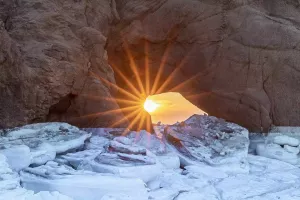When thinking of the wonders of the world, the Great Pyramids or the Colosseum may spring into mind. While unmistakably incredulous, the list below describes the wonders that Mother Nature created at her own will to enchant and put humans in awe at the mere sight of these wonders.
From a pink lake in Australia and an ice-blue terrace in Turkey to colorful caves in Chile and mystical peaks in China, there are plenty of popular, natural wonders to explore around the world. Avid explorers, daredevils, backpackers, expatriates, and tourists should place these 7 natural wonders on their bucket lists.
1. Victoria Falls, border of Zimbabwe and Zambia
Two times as wide and double the depth of Niagara Falls, Victoria Falls is widely considered to be the world's largest waterfall, according to the Encyclopedia Britannica. The roar of the rushing water is so great that it can be heard from a whopping 24 miles away, while the rising mist from the falls can be seen from more than 30 miles away, according to victoriafallstourism.org.
2. Parícutin, Michoacán, Mexico
Another one of the natural wonders of the world is Parícutin. It is a cinder cone volcano which can be found in Michoacán, Mexico. The cone has only really existed as it is since 1943, when it surged up out of the ground in a relatively flat corn field, making it the youngest volcano in the Northern Hemisphere. At the time that it surged, it also erupted, and continued to erupt over a period of 9 years. Now, the volcano is considered to be dormant, and is popular as a tourist attraction.
3. Yosemite, California
Known for its stunning cliffs, burnt-orange sunsets, and bubbling waterfalls, Yosemite is one of the most widely renowned and popular national parks in the US. Yosemite's El Capitan was featured in the 2018 Oscar-winning documentary "Free Solo," but you might also recognize the monolith as the default background on many generations of Mac computers.
4. The Harbor Of Rio De Janeiro, Brazil
The Harbor of Rio de Janeiro can be found in the southeast of Brazil. Also known as Guanabara Bay, it is the world’s largest natural bay, based on volume, and that is why it is classified as one of the seven Natural Wonders of the world. The bay is a huge expanse of water, which is surrounded by granite rock formations and monoliths which add to the striking visual appeal of the area. Though the harbor has also become a massive hub of human activity, from the city of Rio to public beaches such as copacabana and an active harbor, the natural beauty of the bay remains, and it is clear to any visitors that the region is a true natural beauty.
5. Salar de Uyuni, Bolivia
The largest salt flat on the planet, Salar de Uyuni is a 4,086-square-mile expanse of salt-crusted earth, according to National Geographic. When nearby lakes overflow, however, the region transforms into a stunning reflective pool that looks absolutely otherworldly.
6. The Great Barrier Reef, Australia
As the world's largest coral reef, the Great Barrier Reef includes over 900 islands, roughly 3,000 separate reefs, and sustains a diverse ecosystem. Measuring approximately 2,300 kilometers in length, it covers an immense area of the ocean, much of it a long way offshore. Boat trips and excursions offer visitors a chance to experience the highlights of the Great Barrier Reef. Snorkeling or dive trips can be arranged, and provide opportunities to see colorful fish, coral, and marine life. Tours can be day trips or multi-day excursions. Popular destinations from which to explore the reef include Cairns, Port Douglas, and the Whitsunday Islands.
7. Mount Everest, border of Nepal and China
The tallest summit on Earth, Mount Everest stretches a whopping 29,035 feet into the sky above the border of Nepal and China, according to Encyclopedia Britannica. Ascending this mammoth Himalayan peak is an impressive feat attempted by few, and accomplished by even fewer.


